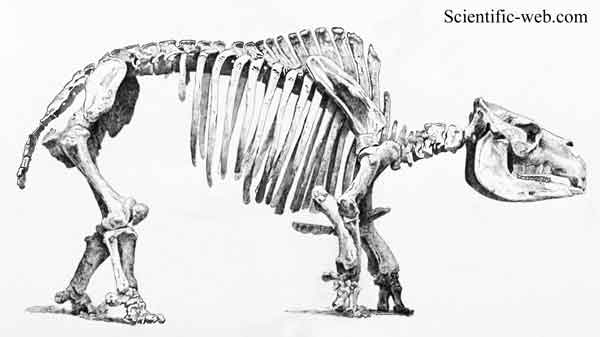
Toxodon, * http://www.toyen.uio.no/palmus/galleri/montre/english/a31962_63.htm Toxodon platensis - brief description and fossil skull
| Toxodon Fossil range: Late Pliocene to Late Pleistocene |
||||||||||||||
|---|---|---|---|---|---|---|---|---|---|---|---|---|---|---|
| Scientific classification | ||||||||||||||
|
||||||||||||||
| Type species | ||||||||||||||
| †Toxodon platensis |
||||||||||||||
| Species | ||||||||||||||
|
Toxodon is an extinct mammal of the late Pliocene and Pleistocene epochs about 2.6 million to 1,800 years ago. It was indigenous to South America, and was probably the most common large hoofed mammal in South America at the time of its existence.
Charles Darwin was one of the first to collect Toxodon fossils in South America. Since Darwin discovered that the fossils of similar mammals of South America were different than those in Europe, he invoked many debates about the evolution and natural selection of animals.
Description
Toxodon was about 2.7 metres (8.9 ft) in body length, and about 1.5 metres (4.9 ft) high at the shoulder and resembled a heavy rhinoceros, with a hippopotamus-like head. Because of the position of its nasal openings, it is believed that Toxodon had a well developed snout. It had a massive skeleton, which suggests that it supported a large muscular body. It had short stout legs with three functional toes, with most of the body weight being borne by the central toe.
The vertebrae were equipped with high apophyses, which most likely supported the massive weight and muscles as well as its powerful head. Toxodon had broad jaws which were filled with bow shaped teeth and incisors. These teeth would have allowed the animal to tear through and bite off the plants and leaves.
It was initially believed to have been amphibious, but after examining the proportions of the femur and tibia, as well as the position of its head, below the top of the spinal column, palaeontologists realised that it had similar features to terrestrial animals such as elephants or rhinoceroses. The fossils are also usually found in arid and semi-arid areas, typically an indication of a primarily terrestrial life.
Extinction
Toxodon became extinct at the end of the Pleistocene when North America and South America met and a migration of more competitive herbivores came about, as well as efficient predators such as Smilodon. In addition, many Toxodon fossils have been found accompanied by fossilized arrow heads. This shows that prehistoric humans hunted them, which could have been a leading cause of their demise.
References
* Barry Cox, Colin Harrison, R.J.G. Savage, and Brian Gardiner. (1999): The Simon & Schuster Encyclopedia of Dinosaurs and Prehistoric Creatures: A Visual Who's Who of Prehistoric Life. Simon & Schuster.
External links
* http://www.toyen.uio.no/palmus/galleri/montre/english/a31962_63.htm Toxodon platensis - brief description and fossil skull
Retrieved from "http://en.wikipedia.org/"
All text is available under the terms of the GNU Free Documentation License

